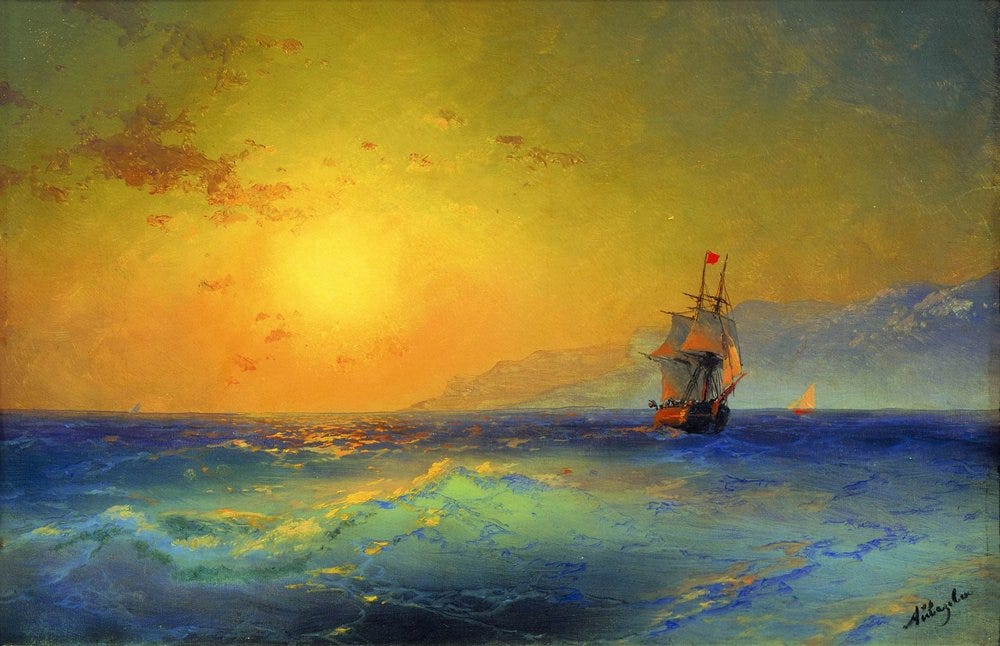First, we can see that the beauty of something in nature is independent of its 'natural' features. The diamond has the same basic chemical make up as coal, but the former is beautiful and the latter is not. The song of the nightingale and the "frantic caterwauling of a love-sick cat" play the same basic biological function, but one is beautiful and the other is not.
So what makes one beautiful and not the other? The answer: The way that the natural or material is joined with something super-natural--an idea or principle (or *logos*)--in a way that we recognize as pleasing and intrinsically valuable. The super-material principle is *incarnated* in and *transfigures* the material aspect. In a diamond the ray of light and the clump of carbon combine to embody what neither can alone, the idea of the transfiguration of dark absorption into a free "bearer of the principle of light which reveals its own content in the play of colors." The song of the nightingale "is the transfiguration of the sexual instinct, its liberation from the crude physiological fact--it is the animal sex instinct embodying in itself *the idea of love*."
Given this, Solovyov insists that we make two different distinctions with respect to beauty. The first is the distinction between its "general ideal essence" and its "specific aesthetic form." The ideal essence of beauty is "being that has value, absolute 'all-unity', freedom of particular existence in the universal unity". But, says Solovyov, this is also the ideal essence of goodness and truth. It is this same essence that we think as truth and desire as highest good; all that is true or good embodies in some way this essence. But to *sense* it as beauty, it must be embodied in material reality.
Second, we must distinguish between evaluation of the ideal embodied and *how* it is embodied, between the idea of "the greatest possible independence of parts combined with the greatest possible unity of the whole" and the "complete and many-sided embodiment of this ideal in the given material." This distinction is fairly easy to make in the case of art, where we can easily distinguish between the goodness of an idea and how well it is executed. But in nature it is a bit more difficult. To illustrate, Solovyov compares the diamond again to a tapeworm. Since life is always a higher expression of the fundamental ideal than non-life, the tapeworm is in that sense better. But, on the other hand, a tapeworm represents so little of what life can be, whereas "the diamond is an object perfect of its kind" ("for nowhere else is such a power of resistance or impenetrability united with such luminosity, nowhere else do we find such vivid and subtle play of light upon so hard a body"). Therefore, from a purely aesthetic view, the diamond must be ranked higher.
As far as a hierarchy of natural beauty, Solovyov thinks is follows more or less the creation-process: first, the heavens, then the earth, then biological life with humanity as its crown: "The all-embracing sky is beautiful as the image of universal unity, as the expression of serene triumph, of the eternal victory of the principle of light over chaotic confusion, of the eternal incarnation of the Idea in the whole of material existence."
Passing to earth, he focuses especially on the beauty of water, which already foreshadows the dynamic unity of life:
The beauty of visible life in the inorganic world is noticeable first of all in flowing water in its various forms-streams, mountain-rivers, waterfalls. The aesthetic significance of this living movement is enhanced by its boundlessness, which seems as it were to express the insatiable longing of finite beings separate from the absolute all-inclusive unity.
And the boundless sea itself acquires a new beauty in its stormy motion as the symbol of rebellious life, of the gigantic struggle of elementary forces which cannot break the universal interconnectedness of the cosmos or destroy its unity, and only fill it with movement, brilliance and thunder.
As we move to biological life and to higher forms of such life, the possibilities for beauty are increased but become at the same time less pervasive and striking. "The beauty of living (organic) beings is higher, but at the same time rarer than the beauty of inorganic nature; we know, too, that positive hideousness begins only where life begins. Passive plant-life offers but little resistance to the ideal principle which embodies in it the beauty of pure forms that have not much content. The chaotic element...first awakes to active self-assertion in the animal life and mind, opposing its inner insatiableness to the objective idea of a perfect organism."
Solovyov ends with a discussion of the idea of creation as itself a living and dynamic embodiment of ideal principle. The development of the world itself is of an increasing and increasingly conscious realization of difference-in-unity. Creation unconsciously tends towards the emergence of life, and living things by their nature beautify themselves. "Even in the animal world, as has just been shown, the general cosmic purpose is attained with the help and co-operation of the creatures themselves, through exciting in them certain inner feelings and strivings. Nature does not build up or adorn animals as some external material, but makes them build up and adorn themselves." Finally, we reach humanity, who "not merely participates in the activity of cosmic principles, but is capable of knowing the purpose of that activity and consequently striving to achieve it freely and consciously."





